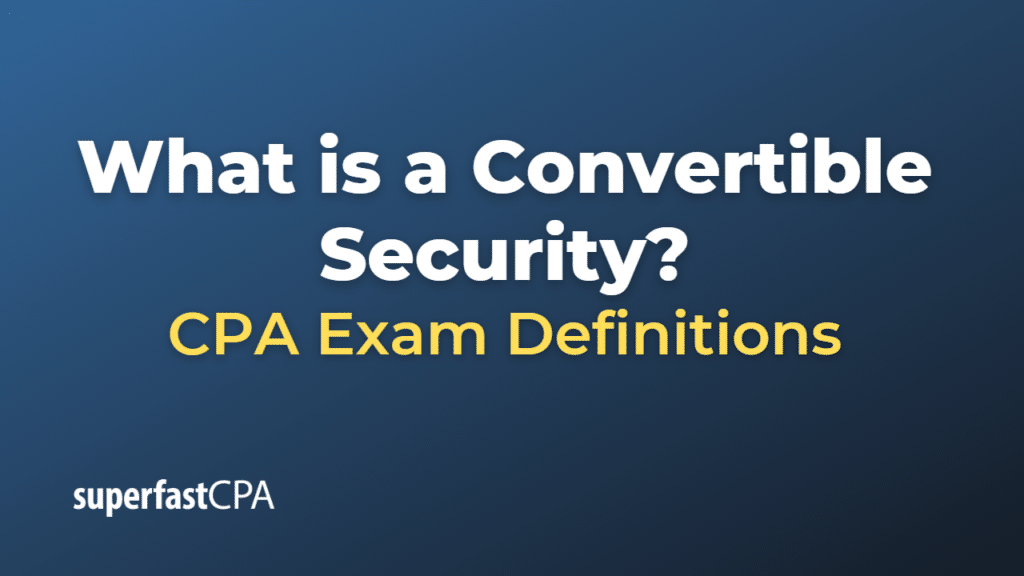Convertible Security
A convertible security is a financial instrument that can be converted into another form of security, typically common stock of the issuing company, at a predetermined conversion ratio and price. Convertible securities combine features of debt instruments (bonds or notes) or preferred stock with the potential for capital appreciation through conversion into common stock.
The two most common types of convertible securities are:
- Convertible Bonds: These are corporate debt instruments that pay periodic interest to bondholders and can be converted into a specified number of common shares of the issuing company at the bondholder’s discretion, usually before the bond’s maturity date.
- Convertible Preferred Stock: This is a type of preferred stock that pays regular fixed dividends to shareholders and grants them the option to convert their preferred shares into a predetermined number of common shares of the issuing company, typically at the shareholder’s discretion.
Key features of convertible securities include:
- Income Generation: Convertible securities, like bonds or preferred stocks, provide regular income to the holder through interest or dividend payments.
- Convertibility: Convertible securities allow the holder to convert their security into common shares of the issuing company at a predetermined conversion ratio, which determines the number of common shares received for each convertible security.
- Capital Appreciation Potential: Convertible securities offer investors the potential for capital appreciation if the market price of the common shares increases. By converting their securities into common shares, investors can participate in the potential upside of the company’s stock price.
- Downside Protection: Convertible securities typically provide more downside protection than common stock, as they offer the stability of debt or preferred stock instruments through regular income payments and higher claims on the company’s assets in the event of liquidation.
Convertible securities are attractive to investors who seek a combination of income generation, capital appreciation potential, and downside protection. For issuing companies, convertible securities provide a flexible financing option, allowing them to raise capital without immediately diluting the ownership of existing common stockholders.
Example of a Convertible Security
Let’s consider a hypothetical example to illustrate how a convertible security works:
Company XYZ issues a convertible bond with a face value of $1,000, an annual interest rate of 6%, and a conversion ratio of 25. This means that each convertible bond can be exchanged for 25 common shares of Company XYZ.
- Interest Payments: Convertible bondholders receive annual interest payments based on the face value of the bond and the interest rate. In this case, the annual interest payment per bond would be:
Interest Payment = Face Value × Interest Rate
Interest Payment = $1,000 × 0.06
Interest Payment = $60
Convertible bondholders will receive $60 per bond in interest payments each year, typically paid in semiannual installments.
- Convertibility: The conversion ratio is set at 25, meaning that each convertible bond can be converted into 25 common shares of Company XYZ.
Now, let’s assume that after some time, Company XYZ’s common stock price rises to $50 per share. A convertible bondholder might decide to convert their bond into common shares, as the value of the common shares upon conversion would be higher than the bond’s face value:
Value of Common Shares Upon Conversion = Conversion Ratio × Market Price per Share
Value of Common Shares Upon Conversion = 25 × $50
Value of Common Shares Upon Conversion = $1,250
In this scenario, converting the bond into common shares results in a capital gain for the investor, as the value of the common shares ($1,250) is higher than the bond’s face value ($1,000). The investor also benefited from the interest payments received during the time they held the convertible bond.
This example illustrates how a convertible security can provide investors with a combination of income generation through interest payments, capital appreciation potential through conversion into common shares, and downside protection as a debt instrument.













